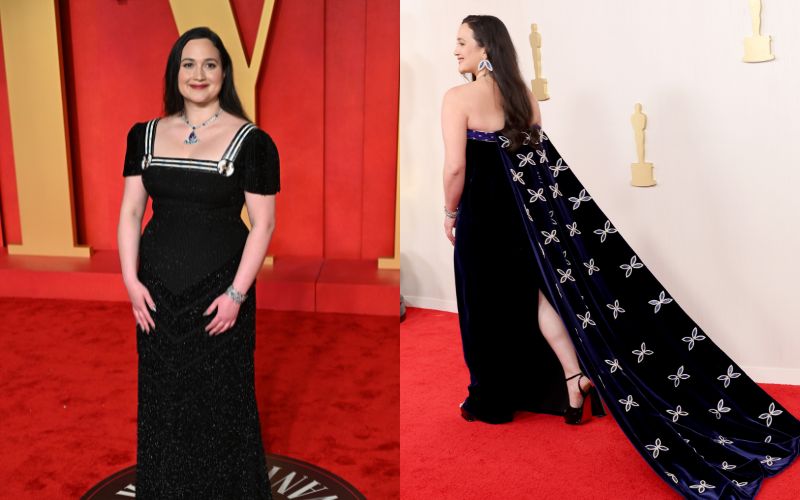
- Details
- By Native News Online Staff
The Smithsonian’s National Museum of the American Indian is featuring two gowns worn by Oscar-nominated actor Lily Gladstone (Blackfeet/Nez Perce) in a special installation called “Making a Statement.”
The exhibition opens to the public on February 28 and will run until March 2026, with four public programs scheduled for March 2025.
The gowns, custom-made collaborations between Gucci and Indigenous artist Joe Big Mountain (Mohawk/Cree/Comanche) of Ironhorse Quilwork, were worn by Gladstone on March 10, 2024, during the 96th Academy Awards ceremony and the Vanity Fair Oscars party.
Gladstone made history as the first Native American nominated for Best Actress for her role in Killers of the Flower Moon, a film directed by Martin Scorsese.
“Lily Gladstone has made it her hallmark to showcase Native designers at star-studded events like the Oscars,” Anya Montiel, museum curator, said in a statement. “The elegant designs mark the first Oscars collaboration between an Indigenous artist and a luxury fashion brand like Gucci. We are thrilled to be able to share these amazing works of art with our visitors.”
The first gown, worn by Gladstone at the Oscars, is a midnight-blue velvet piece featuring a porcupine-quill neckline and a matching cape adorned with 216 hand-quilled and beaded petals.
The second gown, worn at the Vanity Fair Oscars party, is a black corseted dress with a chevron-patterned beaded fringe and a porcupine-quill neckline. This gown incorporates 24-carat gold plated beads, glass beads, and brass sequins.
Porcupine quillwork, a traditional Native art form unique to North America, plays a prominent role in both gowns. The technique of quilling has been passed down through generations within many Indigenous communities. Big Mountain and his team of Native artists ensured that this collaboration honored and protected quillwork knowledge.
In conjunction with the exhibition, the museum will host several programs showcasing Indigenous fashion. Events include a conversation on Indigenous couture with quillwork artist Joe Big Mountain and stylist Jason Rembert, an Indigenous fashion showcase featuring designers like Bethany Yellowtail, a curator-led tour of the exhibition, and a panel on Indigenous women in design moderated by Vogue’s Christian Allaire.
More Stories Like This
Vision Maker Media Honors MacDonald Siblings With 2025 Frank Blythe AwardFirst Tribally Owned Gallery in Tulsa Debuts ‘Mvskokvlke: Road of Strength’
Zuni Youth Enrichment Project and Partners at Ho’n A:wan Productions Launch 8th Annual Delapna:we Project
Chickasaw Holiday Art Market Returns to Sulphur on Dec. 6
Center for Native Futures Hosts Third Mound Summit on Contemporary Native Arts
Help us defend tribal sovereignty.
At Native News Online, our mission is rooted in telling the stories that strengthen sovereignty and uplift Indigenous voices — not just at year’s end, but every single day.
Because of your generosity last year, we were able to keep our reporters on the ground in tribal communities, at national gatherings and in the halls of Congress — covering the issues that matter most to Indian Country: sovereignty, culture, education, health and economic opportunity.
That support sustained us through a tough year in 2025. Now, as we look to the year ahead, we need your help right now to ensure warrior journalism remains strong — reporting that defends tribal sovereignty, amplifies Native truth, and holds power accountable.
 The stakes couldn't be higher. Your support keeps Native voices heard, Native stories told and Native sovereignty defended.
The stakes couldn't be higher. Your support keeps Native voices heard, Native stories told and Native sovereignty defended.
Stand with Warrior Journalism today.
Levi Rickert (Potawatomi), Editor & Publisher


